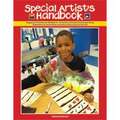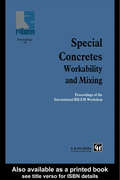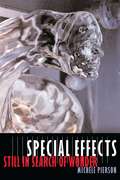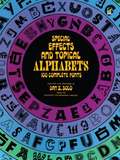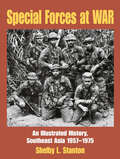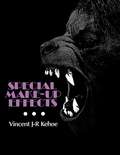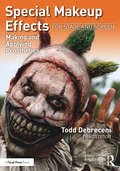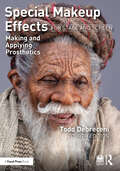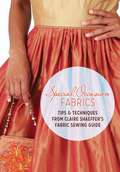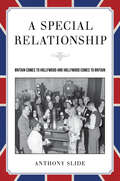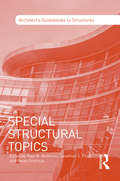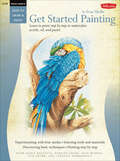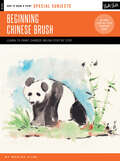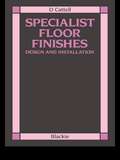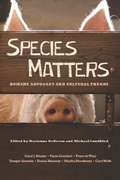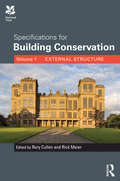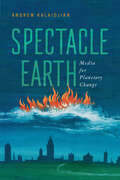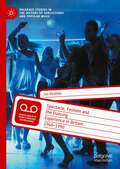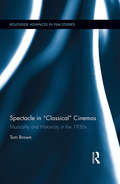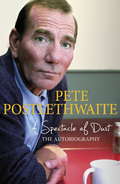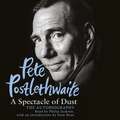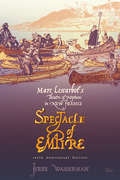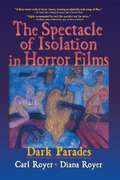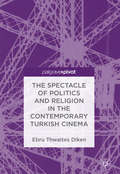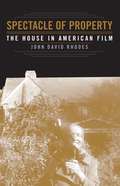- Table View
- List View
Special Artist's Handbook: Engaging Art Activities For Special Needs Including Autism Spectrum Disorder, Second Edition
by Susan RodriguezThe Special Artist's Handbook is an art activities reference manual for art teachers, special education teachers, art teachers, classroom teachers, recreational therapists, parents, and anyone who is involved with the education of exceptional children.
Special Concretes - Workability and Mixing
by Peter J.M.BartosThis book forms the Proceedings of the International RILEM Workshop held in Paisley in March 1993. It contains contributions on theoretical and practical aspects of the use of special concretes, with a particular focus on their behaviour in the fresh state.
Special Effects: Still in Search of Wonder (Film and Culture Series)
by Michele PiersonDesigned to trick the eye and stimulate the imagination, special effects have changed the way we look at films and the worlds created in them. Computer-generated imagery (CGI), as seen in Hollywood blockbusters like Star Wars, Terminator 2, Jurassic Park, Independence Day, Men in Black, and The Matrix, is just the latest advance in the evolution of special effects. Even as special effects have been marveled at by millions, this is the first investigation of their broader cultural reception. Moving from an exploration of nineteenth-century popular science and magic to the Hollywood science fiction cinema of our time, Special Effects examines the history, advancements, and connoisseurship of special effects, asking what makes certain types of cinematic effects special, why this matters, and for whom. Michele Pierson shows how popular science magazines, genre filmzines, and computer lifestyle magazines have articulated an aesthetic criticism of this emerging art form and have helped shape how these hugely popular on-screen technological wonders have been viewed by moviegoers.
Special Effects and Topical Alphabets (Lettering, Calligraphy, Typography)
by Dan X. SoloThe alphabet is the message. With these special effects and topical alphabets, you can advertise or identify a product or service in lettering that reinforces your message. For example: letters shaped like chopsticks; letters made up of logs; letters made up of bones; letters frozen in ice; letters with stars and stripes.These are just a few of the alphabets you can use from the 100 fonts selected by Dan X. Solo from the Solotype Typographers Catalog. All the fonts appear in upper case, while many also have lower case and/or numerals.Whether your message is about the Fourth of July, cool refreshment, outdoor life, modern technology, summer, spring, winter, or a hundred other moods and occasions, you'll find in this collection an alphabet that tells the story. The typographic designs may be sophisticated or naïve, but all are eminently useful and difficult to find in usual sources.
Special Forces at War: An Illustrated History, Southeast Asia 1957–1975
by Shelby L. Stanton“A rare insider’s experience paired with a scholarly historical approach, making it an essential standout for any military library.” —Midwest Book ReviewMore than 8.7 million Americans reported for military duty in Southeast Asia, but only a select few wore the Green Beret, the distinctive symbol of the U.S. Army Special Forces. These elite soldiers played a crucial role during the protracted conflict.Special Forces at War: an Illustrated History, Southeast Asia 1957–1975 by wartime veteran and military historian Shelby L. Stanton shows Special Forces’ activity from the first deployments of Green Berets into battle, through their training, wartime advisory, border surveillance, strike force, and special operations roles.Unprecedented in scope, this photographic history features rare and unpublished images, providing an exclusive, insider view of covert activities such as Project Delta, whose Special Forces-trained Vietnamese commandos posed as North Vietnamese Army or Viet Cong troops behind communist lines. It depicts Special Forces’ camps before, during, and after enemy assaults. It features an array of lethal weapons used by resourceful Green Berets fighting to preserve their remote outposts, as well as allied and enemy documents and propaganda. From ordinary camp life to special missions, no aspect of Special Forces activities during the Second Indochina War has been overlooked.Stanton knows his subject first hand. During six years of active duty as an infantry officer in the U.S. Army, he served as a paratrooper platoon leader, an airborne ranger advisor to the Royal Thai Army Special Warfare Center, and a Special Forces long-range reconnaissance team commander in Southeast Asia before being wounded in combat in Nam Yu, Laos.
Special Make-Up Effects
by Vincent KehoeSpecial Make-Up Effects concentrates on the genre of horror characters and other special creations (fantasy, sci-fi, etc), giving tips about the materials, techniques, and 'tricks of the trade' necessary to create unique make-up effects. This focused volume is a scaled-down version of Vincent Kehoe's encyclopedic reference for professional make-up artists. It contains new segments and photographs. This book shows how many of cinema's most famous characters and effects were developed. It gives students and make-up artists the techniques they need to perform their own magic.
Special Makeup Effects for Stage and Screen: Making and Applying Prosthetics
by Todd DebreceniWith this new edition of Special Makeup Effects for Stage and Screen, author Todd Debreceni presents the latest techniques and special effects in what has become an industry "bible." In addition to genre-specific considerations, Debreceni covers the latest gear you will need and details how to maintain your kit, how to take care of the actor's skin, how to airbrush for HD, and much more. With in-depth, step-by-step tutorials, learn how to sculpt and mold your own makeup prosthetics, focusing on human anatomy to create the most realistic effects. This new and expanded edition features updated information on lifecasting, prosthetics made using 3D printing, advanced airbrushing techniques, new artist profiles, and includes updated images and illustrations throughout. A companion website contains artist profiles that showcase some of the world’s top makeup effects artists, including Steve Wang, Ve Neill, Matthew W. Mungle, Miles Teves, Jordu Schell, and many others. Also included are detailed makeup tutorials led by experts in the field, such as Maddie Singer and Toby Sells.
Special Makeup Effects for Stage and Screen: Making and Applying Prosthetics
by Todd DebreceniWith this new edition of Special Makeup Effects for Stage and Screen, author Todd Debreceni presents the latest techniques and special effects in what has become an industry "bible." In addition to genre-specific considerations, Debreceni covers the latest gear you will need and details how to maintain your kit, how to take care of the actor's skin, how to airbrush for HD, and much more. With in-depth, step-by-step tutorials, learn how to sculpt and mold your own makeup prosthetics, focusing on human anatomy to create the most realistic effects. This new and expanded edition features updated information on lifecasting, prosthetics made using 3D printing, advanced airbrushing techniques, and new artist profiles, and includes updated images and illustrations throughout. A companion website contains artist profiles that showcase some of the world’s top makeup effects artists, including Ve Neill, Matthew W. Mungle, and many others. Also included are detailed tutorials led by experts in the field, such as Matthew Mungle, Adrian Rigby, Stuart Bray, and of course, the author himself.
Special Occasion Fabrics
by Claire ShaefferLet internationally respected author, lecturer, college instructor and columnist Claire Shaeffer teach you how to wear, sew and care for special occasion fabrics, from satin and taffeta to silk and velvet. Packed with design ideas, sewing checklists, and helpful sewing notes that cover everything from darts to pockets, Special Occasion Fabrics has all the information you need to sew something special!
A Special Relationship: Britain Comes to Hollywood and Hollywood Comes to Britain
by Anthony SlideA Special Relationship provides not only a historical overview of the British in Hollywood, but also a detailed study of the contributions made by American individuals and companies to British cinema from the beginning of the twentieth century onwards. The story begins with Ohio-born Charles Urban who came to London in 1898 and deserves credit for major involvement in the creation of a British film industry. While Ireland was still a part of Britain, the New York-based Kalem Company made films there from 1910 to 1913. British producers realized the importance of American stars, and many actors, beginning with Florence Turner (who was arguably also the first American star), made numerous British films. In the 1920s, such Hollywood stars as Mae Marsh, Betty Blythe, and Dorothy Gish remained active in Britain. In the 1930s, as their careers came to a halt, more than one hundred former American stars made the trip to England, partly as a vacation and partly in the hope of reenergizing their careers.Chapters discuss American cinematographers at work in Britain in the 1920s and 1930s and the introduction of Technicolor to British films. Diversity is represented by African American performers (most notably Paul Robeson), the Chinese American star Anna May Wong, along with female filmmakers from Hollywood. With Britain's declaration of war on Germany, there were Americans who stayed, such as Bebe Daniels and Ben Lyon, contributing to the war effort. America became actively involved in British cinema after World War II, with many Hollywood studios producing films there. As the years progressed, the British film industry became an international film industry. The book concludes with the Harry Potter and James Bond series, indicative of a new international cinema, with financing and behind-the-camera talent coming from the United States, but with British locales and British stars.
Special Structural Topics (Architect's Guidebooks to Structures)
by Paul W. McMullin Jonathan S. Price Sarah SimchukSpecial Structural Topics covers specialty structural situations for students and professional architects and engineers, such as soil mechanics, structural retrofit, structural integrity, cladding design, blast considerations, vibration, and structural sustainability. As part of the Architect’s Guidebooks to Structures series, it provides a comprehensive overview using both imperial and metric units of measurement with more than 150 images. As a compact summary of key ideas, it is ideal for anyone needing a quick guide to specialty structural considerations.
Special Subjects: In Four Media (How to Draw & Paint)
by Marla Baggetta Marilyn Grame Geri Medway Tom SwimmLearn how to paint in four different media! Taking the first steps to learn how to paint can be a challenge, especially when beginning artists are unsure which medium best suits them. With this book, aspiring artists will discover the qualities and benefits of four painting media-acrylic, oil, pastel, and watercolor-making it easier for them to begin their artistic journey. After an in-depth introduction to the tools and materials needed for each medium, five accomplished artists guide readers step by step through the creation of their own works of art.
Special Subjects: Beginning Chinese Brush
by Monika CilmiWith comprehensive instruction and artist tips and tricks, Special Subjects: Beginning Chinese Brush is the perfect resource for beginning artists. Explore and experience this traditional medium!Special Subjects: Beginning Chinese Brush teaches aspiring artists everything they need to know to get started creating Chinese brush paintings. From choosing brushes to painting techniques, composition, and development, Special Subjects: Beginning Chinese Brush is bursting with valuable skills and lessons to help you learn how to use this traditional medium. Artist Monika Cilmi guides you through an exploration of a variety of step-by-step Chinese brush paintings, covering basic concepts and techniques, such as different brushstrokes, as well as how to blend traditional methodswith your own personal style. Building on these introductory techniques, you can practice your craft with projects that cover a variety of subjects, including birds, flowers, and traditional landscapes. This is one tool that no artist will want to be without!
Specialist Floor Finishes: Design and Installation
by D CattellFirst Published in 1989. Routledge is an imprint of Taylor & Francis, an informa company.
Species Matters: Humane Advocacy and Cultural Theory
by Marianne DeKoven Michael LundbladWhy has the academy struggled to link advocacy for animals to advocacy for various human groups? Within cultural studies, in which advocacy can take the form of a theoretical intervention, scholars have resisted arguments that add "species" to race, class, gender, sexuality, disability, and other human-identity categories as a site for critical analysis. Species Matters considers whether cultural studies should pay more attention to animal advocacy and whether, in turn, animal studies should pay more attention to questions raised by cultural theory. The contributors to this volume explore these issues particularly in relation to the "humane" treatment of animals and various human groups and the implications, both theoretical and practical, of blurring the distinction between "the human" and "the animal." They address important questions raised by the history of representing humans as the only animal capable of acting humanely and provide a framework for reconsidering the nature of humane discourse, whether in theory, literary and cultural texts, or current advocacy movements outside of the academy.
Specifications for Building Conservation: Volume 1: External Structure
by Rick Meier Rory CullenIn Specifications for Building Conservation, the National Trust draws on a range of case studies and specifications to provide a much needed guide to specification writing for building conservation. Although traditional building accounts for approximately a quarter of all buildings in the UK, the old skills and understanding required for their care and maintenance have been increasingly eroded over the last century. As the largest heritage charity in Europe, the National Trust has a first class reputation for high standards of conservation and care, and in this three volume set, the Trust brings together a remarkable pool of expertise to guide conservation professionals and students through the process of successful specification writing. This first book focusses on the materials used for the external fabric, detailing successful approaches employed by the National Trust at some of their most culturally significant sites. A range of studies have been carefully selected for their interest, diversity and practicality; showcasing projects from stonework repairs on the magnificent Grade I listed Hardwick Hall to the re-thatching of the traditional cottages of the Holnicote Estate. Complete with a practical Conservation Management Plan checklist, this book will enable practitioners to develop their skills, allowing them to make informed decisions when working on a range of project types. This is the first practical guide to specification writing for building conservation and the advice provided by the National Trust experts will be of interest to any practitioners and students involved in building conservation, both in the UK and beyond. Profits generated from the sale of this publication will go to the National Trust Building Apprenticeship Scheme. This provides placements for traditional skills at National Trust properties.
Spectacle Earth: Media for Planetary Change (Cultural Frames, Framing Culture)
by Andrew KalaidjianArtistic, literary, and technological depictions of the climate crisis and how they influence humanity&’s response What does it mean to watch a disaster unfold? Does exposure to a source of dread spur people to action or lull them into fatalism and complacency? Andrew Kalaidjian takes up these and other vital questions in Spectacle Earth, a lively and wide-ranging consideration of media engagement, passivity, and virtual environments in relation to ecological crises and climate change. Kalaidjian begins by tracing the long trajectory of environmental aesthetics and natural sciences that have led up to the Anthropocene. He then looks at the lessons learned from artist and activist movements of the 1960s and 1970s before laying out the new challenges in the digital age of artificial intelligence, cloud computing, and virtual reality. The result is groundbreaking, offering readers a new media literacy that goes beyond individual therapeutic experience to provide forms of expression that can lead to the sorts of solidarity and connection needed to change the planet for the better.
Spectacle, Fashion and the Dancing Experience in Britain, 1960-1990 (Palgrave Studies in the History of Subcultures and Popular Music)
by Jon StrattonThis book explores dancing from the 1960s to the 1980s; though this period covers only twenty years, the changes during it were seismic. Nevertheless continuities can be found, and those are what this book examines. In dancing, it answers how we moved from the self-control that formed the basis for ballroom dancing, to ecstatic rave dancing. In terms of music, it answers how we moved from the beat groups to electronic dance music. In terms of youth, it answers how we moved from youth culture to club culture.
Spectacle in Classical Cinemas: Musicality and Historicity in the 1930s (Routledge Advances in Film Studies)
by Tom BrownSpectacle is not often considered to be a significant part of the style of ‘classical’ cinema. Indeed, some of the most influential accounts of cinematic classicism define it virtually by the supposed absence of spectacle. Spectacle in ‘Classical’ Cinemas: Musicality and Historicity in the 1930s brings a fresh perspective on the role of the spectacular in classical sound cinema by focusing on one decade of cinema (the 1930s), in two ‘modes’ of filmmaking (musical and historical films), and in two national cinemas (the US and France). This not only brings to light the special rhetorical and affective possibilities offered by spectacular images but refines our understanding of what ‘classical’ cinema is and was.
A Spectacle of Dust: The Autobiography
by Pete PostlethwaiteVibrant and candid memoirs of the late, great British character actor, Pete Postlethwaite.After training as a teacher, Pete Postlethwaite started his acting career at the Liverpool Everyman Theatre where his colleagues included Bill Nighy, Jonathan Pryce, Antony Sher and Julie Walters. After routine early appearances in small parts for television programmes such as THE PROFESSIONALS, Postlethwaite's first success came with the acclaimed British film DISTANT VOICES, STILL LIVES in 1988. He then received an Academy Award nomination for his role in THE NAME OF THE FATHER in 1993. His performance as the mysterious lawyer "Kobayashi" in THE USUAL SUSPECTS is well-known, and he appeared in many successful films including ALIEN 3, BRASSED OFF, THE SHIPPING NEWS, THE CONSTANT GARDENER, as Friar Lawrence in Baz Luhrmann's ROMEO + JULIET, and in INCEPTION with Leonardo diCaprio. Pete Postlethwaite was one of the best-loved and widely admired performers on stage, TV (SHARPE, THE SINS) and in cinema. In THE ART OF DISCWORLD, Terry Pratchett said that he had always imagined Sam Vimes as 'a younger, slightly bulkier version of Pete Postlethwaite', while Steven Spielberg called him 'the best actor in the world', about which Postlethwaite said: 'I'm sure what Spielberg actually said was, "the thing about Pete is that he thinks he's the best actor in the world."' This is the story of a diverse and multi-talented actor's eventful life, told in his own candid and vibrant words.
A Spectacle of Dust: The Autobiography
by Pete PostlethwaiteAfter training as a teacher, Pete Postlethwaite started his acting career at the Liverpool Everyman Theatre where his colleagues included Bill Nighy, Jonathan Pryce, Antony Sher and Julie Walters. After routine early appearances in small parts for television programmes such as THE PROFESSIONALS, Postlethwaite's first success came with the acclaimed British film DISTANT VOICES, STILL LIVES in 1988. He then received an Academy Award nomination for his role in THE NAME OF THE FATHER in 1993. His performance as the mysterious lawyer "Kobayashi" in THE USUAL SUSPECTS is well-known, and he appeared in many successful films including ALIEN 3, BRASSED OFF, THE SHIPPING NEWS, THE CONSTANT GARDENER, as Friar Lawrence in Baz Luhrmann's ROMEO + JULIET, and in INCEPTION with Leonardo diCaprio. Pete Postlethwaite was one of the best-loved and widely admired performers on stage, TV (SHARPE, THE SINS) and in cinema. In THE ART OF DISCWORLD, Terry Pratchett said that he had always imagined Sam Vimes as 'a younger, slightly bulkier version of Pete Postlethwaite', while Steven Spielberg called him 'the best actor in the world', about which Postlethwaite said: 'I'm sure what Spielberg actually said was, "the thing about Pete is that he thinks he's the best actor in the world."' This is the story of a diverse and multi-talented actor's eventful life, told in his own candid and vibrant words.Read by Philip Jackson (BRASSED OFF), with an introduction by Sean Bean.(p) 2011 Orion Publishing Group
Spectacle of Empire
by Jerry WassermanArguably the first North American play, this edition includes the original French script of Marc Lescarbot's Theatre of Neptune in New France, two twentieth-century English translations, Ben Jonson's Masque of Blackness, and an extensive historical and critical introduction by Jerry Wasserman.
The Spectacle of Isolation in Horror Films: Dark Parades
by Carl Royer B Lee CooperGo behind the scenes with an insightful look at horror films-and the directors who create them The Spectacle of Isolation in Horror Films: Dark Parades examines the work of several of the genre&’s most influential directors and investigates how traditional themes of isolation, alienation, death, and transformation have helped build the foundation of horror cinema. Authors Carl and Diana Royer examine the techniques used by Alfred Hitchcock that place his work squarely in the horror (rather than suspense) genre, discuss avant-garde cinema&’s contributions to mainstream horror, explore films that use the apartment setting as the "cell of horror," and analyze how angels and aliens function as the supernatural "Other." A unique resource for film students and film buffs alike, the book also examines Sam Raimi&’s Evil Dead trilogy and the fusion of science, technology, and quasi-religious themes in David Cronenberg&’s films. Instead of presenting a general overview of the horror genre or an analysis of a specific sub-genre, actor, or director, The Spectacle of Isolation in Horror Films offers an imaginative look at classic and contemporary horror cinema. The book examines Surrealist films such as Un Chien Andalou and Freaks, the connections among the concepts of voyeurism, paranoia, and alienation in films like Rear Window, Rosemary&’s Baby, Blue Velvet, and The Blair Witch Project; the use of otherworldly creatures in films such as The Prophecy, Dogma, and The Day The Earth Stood Still; and the films of directors George Romero, John Waters, and Darren Aronofsky, to name just a few. This unique book also includes an extensive A-to-Z filmography and a bibliography of writings on, and about, horror cinema from filmmakers, film critics, and film historians. The Spectacle of Isolation in Horror Films examines: "Body Doubles and Severed Hands"-the common ancestry of avant-garde "art" films and exploitation horror B-movies "And I Brought You Nightmares"-recurring themes of psychological terror in Alfred Hitchcock&’s films "Horror, Humor, Poetry"-Sam Raimi&’s transformation of "drive-in" horror cinema "Atheism and 'The Death of Affect'"-David Cronenberg&’s obsessions, interests, and cautionary messages in films ranging from Videodrome to Dead Ringers to eXistenZ and much more!The Spectacle of Isolation in Horror Films: Dark Parades is a unique resource of critical analysis for academics working in film and popular culture, film historians, and anyone interested in horror cinema.
The Spectacle of Politics and Religion in the Contemporary Turkish Cinema
by Ebru Thwaites DikenThis book explores how politics, religion and cinema encounter and re-invent each other in contemporary Turkish cinema. It investigates their common origin—the spectacle, which each field views as an instrument of governmentality. The book analyses six recent, some of which are internationally known Turkish films: The Messenger (Ulak), A Man’s Fear of God (Takva), Let’s Sin (İtirazım Var), SixtyOne Days (İftarlık Gazoz), The Imam and The Shadowless (Gölgesizler). Thwaites discusses how the cinematic nature of politics and religion unfold amidst the increasing media visibility of religion in contemporary Turkey. The chapters explore the relationship between art and religion, and compare religion and philosophy in their relation to truth, belief, and economy. Through close examination of these films, the author highlights the role of cinema in contemporary Turkey and at the heart of the religious paradigm.
Spectacle of Property: The House in American Film
by John David RhodesMuch of our time at the movies is spent in other people&’s homes. Cinema is, after all, often about everyday life. Spectacle of Property is the first book to address the question of the ubiquitous conjuncture of the moving image and its domestic architecture. Arguing that in cinema we pay to occupy spaces we cannot occupy, John David Rhodes explores how the house in cinema both structures and criticizes fantasies of property and ownership.Rhodes tells the story of the ambivalent but powerful pleasure we take in looking at private property onscreen, analyzing the security and ease the house promises along with the horrible anxieties it produces. He begins by laying out a theory of film spectatorship that proposes the concept of the &“spectator-tenant,&” with reference to films such as Gone with the Wind and The Magnificent Ambersons. The book continues with three chapters that are each occupied with a different architectural style and the films that make use of it: the bungalow, the modernist house, and the shingle style house. Rhodes considers a variety of canonical films rarely analyzed side by side, such as Psycho in relation to Grey Gardens and Meet Me in St. Louis. Among the other films discussed are Meshes of the Afternoon, Mildred Pierce, A Star Is Born, Killer of Sheep, and A Single Man.Bringing together film history, film theory, and architectural history as no book has to date, Spectacle of Property marks a new milestone in examining cinema&’s relationship to realism while leaving us vastly more informed about, if less at home inside, the houses we occupy at the movies.
